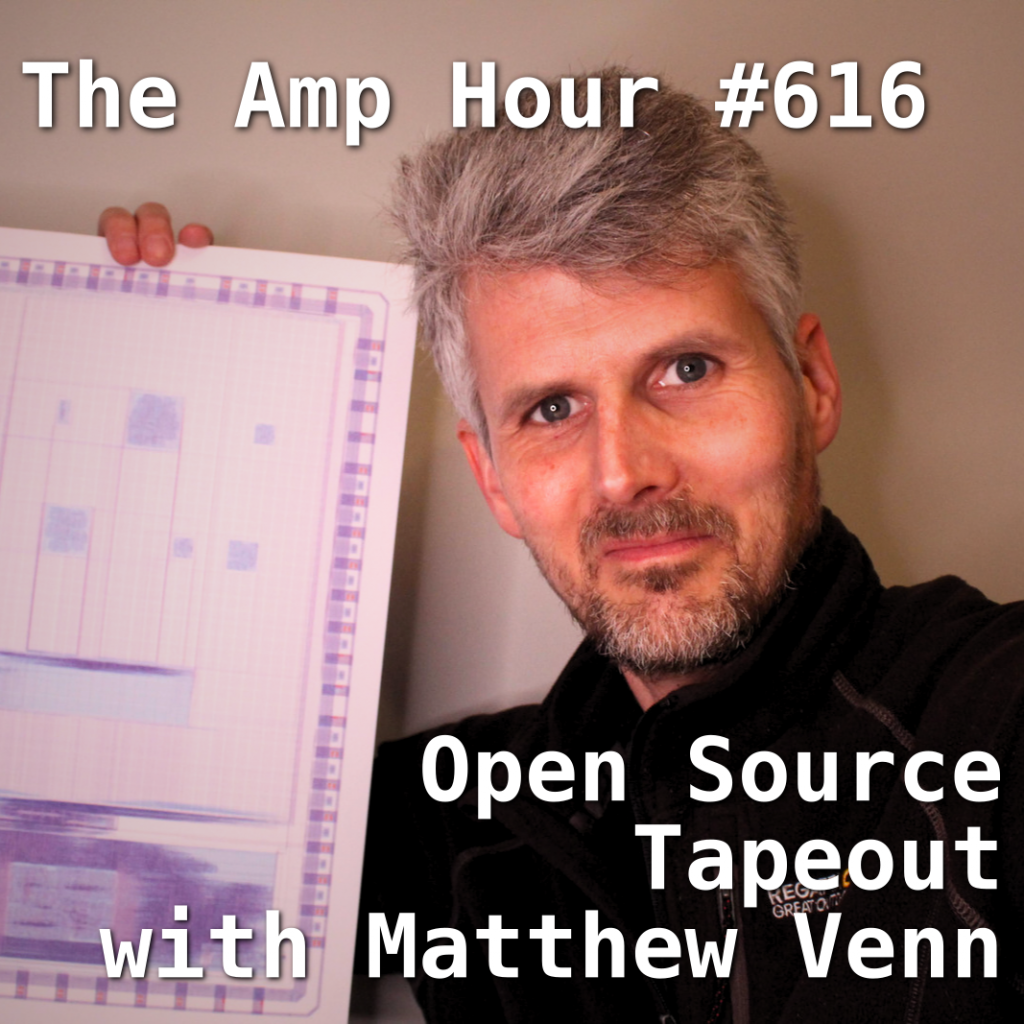#616 – Open Source Tapeout with Matthew Venn
Manage episode 353216071 series 2946405
Innhold levert av The Amp Hour (Chris Gammell and David L Jones), The Amp Hour (Chris Gammell, and David L Jones). Alt podcastinnhold, inkludert episoder, grafikk og podcastbeskrivelser, lastes opp og leveres direkte av The Amp Hour (Chris Gammell and David L Jones), The Amp Hour (Chris Gammell, and David L Jones) eller deres podcastplattformpartner. Hvis du tror at noen bruker det opphavsrettsbeskyttede verket ditt uten din tillatelse, kan du følge prosessen skissert her https://no.player.fm/legal.

Welcome back to the show, Matthew Venn!
- Matt was previously on Episode 467 from 2019 Supercon, before he started working on the open source toolchains and the education around them.
- A bunch of news in the open source silicon space
- Latest shuttle was MPW8, MPW9 coming up soon
- 2 new open PDKs
- Open source tools growing, much of it comes from Google “Willy Wonka-ing” process and sponsoring the shuttle
- This was driven by past guest Tim Ansell (on 501)
- Tim Edwards of efabless
- Claire Wolf was on the show in the past
- Dan Burke talked with Matt at Supercon 2023 about the term “Tapeout”
- Matt runs the ZeroToAsicCourse youtube channel, which includes a podcast.
- Global Foundries / IHP open source
- What is driving the growth?
- Open source tools
- Google MPW
- Open source PDK
- RISC V
- Ming Zhang on The Amp Hour talking about chiplets with ZGlue (now defunct).
- If you don’t get into the lottery, you can pay efabless $10K for 300 chips
- Packaging is also tough
- Volume problems – What happens between 300 chips and 10K chips?
- Why should people get started with trying out the open source tools?
- Why are people signing up for the couse?
- 30-50% want to understand silicon
- 20% are academic — many Universities are switching to the open source toolchain
- 20-30% are commercial users who might want to use the info for
- Reasons for going custom silicon as a business?
- Security by obscurity
- Space
- Power
- Sourcing (?)
- MPW gives you about 10 sq mm
- Matt put more designs onto his MPW slot, bundling even more designs (which has continued on)
- OpenRAM
- You could fit 25K of SRAM on 10 sq mm
- #OpenSourceASICHighlight
- Mohamed Kassem of eFabless was on the show in the past. eFabless highlights designs on their site.
- Check out the 2022 highlight video from Matt!
- Open Tapeout
- FOSSI foundation runs the Latchup Conference
- OSDA
- India driving growth of chip design, many large scale companies also have verification teams in india
- Security and “inspectability” from cloud companies
- Root of trust chips – Laura from Oxide talked about this when she was on the show.
- TSMC has an educational program for students in Taiwan
- TinyTapeout
- Extension of the course, joining designs together with a tristate bus
- “Vosotros” is the “y’all” of the Spanish language
- HDL is mostly controlled by the tools
- OpenLane by eFabless was based on OpenRoad
- TinyTapeout is meant for beginners
- Uri from Wokwi (on show 599) worked with Matt on TinyTapeout
- He added gates to Wokwi, which then can be connected together. The program pushes the gates out, which then can be synthesized.
- You’re closer to the hardware with Wokwi than you will be with Verilog.
- 500-600 standard cells in tiny tapeout
- The Shuttle lottery is getting harder to win
- There are more TinyTapeout slots
- It costs $25 for design only, $100 for chips
- When you get the chip back on a PCB, you select your design (or others!) with a DIP switch
- Check out what was on the TinyTapeout 2nd run
- Olof Kindgren won the Serv RISC V prize, which is a small bit serial processor. Past guest Greg Davill put that design onto TinyTapeout.
- There is a Discord for the course
- Siliwiz explains how silicon can work, allows you to use sliders to control how the silicon gate sizes change.
- A wafer will take 6 months start to finish if all goes well.
- MPW1-4 had a hold violation. Sylvain (TNT) who was also on episode 467 did some wizardry to get things working!
- Siliwiz still not open to public
- What does it take to tape out a design? Putting the logic inside of other logic when creating a wafer. Then eFabless takes care of the rest.
- The harness with everything that allows you to access the low level IO is called “caravel”
- Europractice is another IC service
50 episoder




